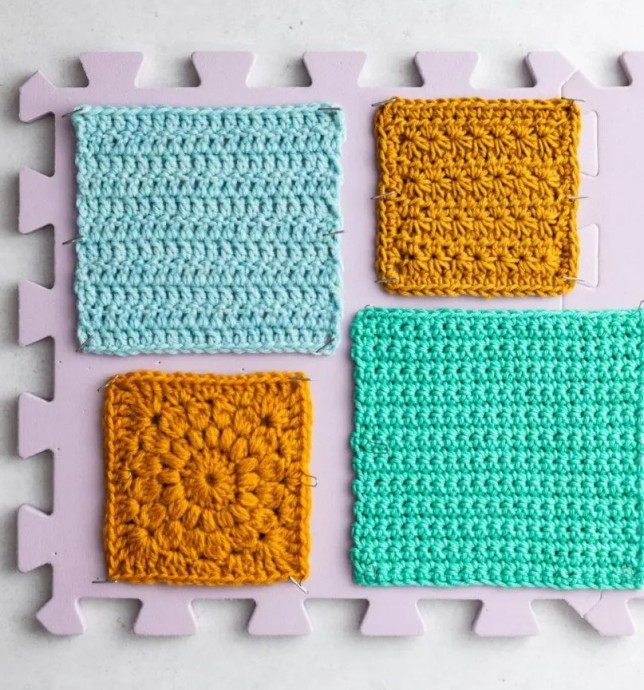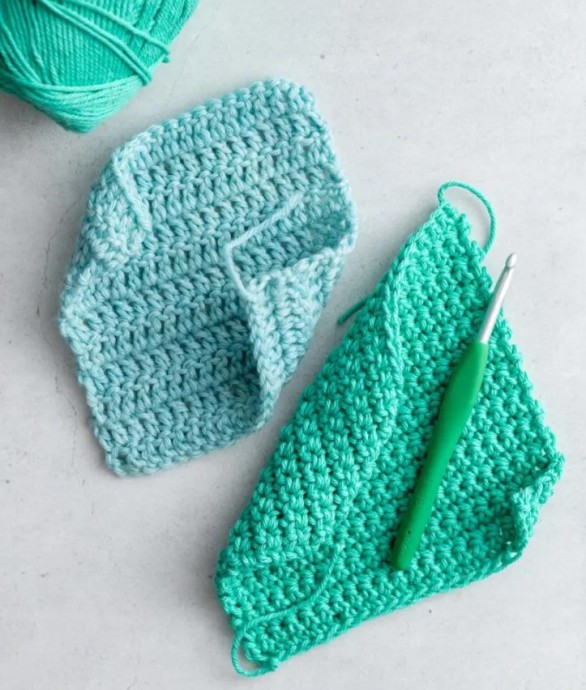How to Block Crochet

Blocking is the best way to give your crochet a beautiful, professional finish – and it’s easier than you think! Read on to learn three easy ways to block crochet for stunning results!
What is Blocking?
Blocking is a finishing technique that makes your crochet look its absolute best. It helps even out the stitches and sets the final size and shape.
Blocking can seem intimidating if you’ve never done it before, but it’s as simple as getting your project wet, shaping it how you want, and then letting it dry. That’s it!
Why block? Here are a few reasons:
- Blocking helps even out your tension so that your stitches look neat and uniform.
- Blocking helps set the final dimensions of your project so it fits correctly.
- Blocking opens up lacework patterns so that you can really see the design.
- Blocking improves the drape of fabric, and helps flatten curling edges.
When is Blocking Necessary?
When should you take the time to block a project? I recommend blocking any project that you plan to display, wear, or gift to someone else.
You should definitely block these types of projects:
- Gauge swatches – Blocking helps you get the most accurate gauge measurements.
- Garments – Block each panel before seaming them together, or block the entire garment once finished.
- Openwork, lace, mesh, and filet crochet – Blocking opens up the spaces in the design.
- Granny squares and other motifs – Blocking makes all your granny squares the same size so they’re easier to assemble into a larger project.
- Tunisian crochet and other curling stitches – Blocking helps to flatten stitches patterns that curl up at the edges in Tunisian crochet work.
You can probably skip blocking for:
- Dishcloths or other small utility pieces that don’t need to look perfect.
- Amigurumi or toys.
What Tools Do I Need for Blocking?
Alright, let’s talk tools. Having the right supplies makes blocking so much easier. And while this list looks like a lot, most of the items are basics you already have around the house.
A blocking surface – This needs to be something flat and firm that you can stick pins in – and that can stand to get a little wet. Yarn stores sell specialty blocking mats that work great. You can also use yoga mats, foam core boards from the craft store, and interlocking exercise mats. In a pinch, you can use towels on a table or carpet – but remember that the surface underneath will get damp.
Rust-proof pins – Regular pins can rust and stain your project. So, you’ll want to invest in some stainless steel blocking pins for best results.
Water source – This depends on your blocking method. For wet blocking, use a sink, tub, or basin. For spraying, use a spray bottle of plain water. For steam blocking, you’ll need an iron with a steam setting or a garment steamer.
Absorbent towels – Use these to press out excess water from your projects.
Tape measure or ruler – You’ll need these to pin your project out to its final dimensions.
Pre-Blocking Prep
Before you get blocking, here are a couple of key things to check:
Read the care label on your yarn. Follow the recommendations so you don’t felt or otherwise ruin the yarn.
Test your blocking method on your gauge swatch first. Remember that gauge swatch you made earlier? Block that swatch first to see how the yarn reacts: Is it colorfast or does the dye bleed? How much does the gauge change? How long does it take to dry?
3 Easy Blocking Methods
There are three different methods of blocking:
- Wet blocking
- Spray blocking
- Steam blocking
Depending on your project and the yarn you’ve used, you may prefer one method over the others.
Wet Blocking
Wet blocking is the process of soaking a crocheted piece in water, gently squeezing out the excess moisture, shaping it, and allowing it to air dry.
This method works well for:
- Natural fiber yarns such as wool, cotton, and linen.
- Lacework or open stitch patterns that you want to block aggressively.
Avoid this method for:
- Very delicate or loosely spun yarns that might stretch too much when soaking wet.
Materials you’ll need:
- A basin or sink for soaking
- Mild detergent or wool wash (optional)
- Blocking mat
- Rust-proof pins
- Measuring tape and/or ruler
Here’s how to wet block your crochet project:
- Fill a sink or basin with cool water. Add a small amount of mild detergent or wool wash.
- Submerge your crochet piece in the water and let it soak for 15-20 minutes. The soak time allows the fibers to become fully saturated with water.
- Drain the water and gently press (don’t wring) the item to remove excess water. You can also roll up in a towel to absorb more water.
- Lay the item flat on a blocking mat or a clean, dry towel. Shape it to the desired dimensions. (If it’s a garment, shape it to the measurements specified in the pattern schematic.)
- Insert rust-proof pins at regular intervals around the edges of the piece to hold it in place while it dries.
- Allow your project to dry completely before removing the pins. This could take anywhere from several hours to a couple of days, depending on the thickness of the yarn and the humidity of the room.
Steam Blocking
Steam blocking is the process of using steam to set the fibers. Steam blocking is much quicker than wet blocking and is suitable for most types of yarn. Take extra care when steam-blocking acrylic yarn to avoid melting the fibers.
This method works well for:
- Projects that need a light to moderate amount of shaping.
- Most types of yarns, including heat-tolerant wool, cotton, and linen.
- You can steam block acrylic yarn, too. The high heat permanently relaxes the yarn (sometimes called “killing the yarn”). Just don’t let the iron touch the acrylic, or it could melt and stick to the iron.
Avoid this method for:
- Delicate fibers that are sensitive to heat, like silk.
Materials you’ll need:
- Blocking mats or a flat surface that can withstand heat.
- Rust-proof pins.
- Steam iron or garment steamer.
- Measuring tape and/or ruler.
Here’s how to steam block your crochet project:
- Lay your crochet item out on a blocking mat, and shape it to the desired dimensions.
- Pin it in place using rust-proof pins.
- Set your iron to continuous steam. Hover the iron a few inches above the crochet item and release steam onto the fabric. Move slowly across the entire piece. (Do not touch the yarn with the iron!)
- Allow your project to cool and dry completely before removing the pins.
Spray Blocking
Spray blocking is the process of pinning your crochet piece in place, misting it with water, and allowing it to dry. This gentle blocking method is preferred for delicate items, or fibers that may not react well to heat.
This method works well for:
- Delicate fibers like cashmere, alpaca, or angora.
- Projects that only need a small amount of shaping.
Avoid this method for:
- Projects that require a significant amount of stretching or shaping.
Materials you’ll need:
- Blocking boards or a flat surface covered with towels.
- Rust-proof pins.
- Spray bottle filled with cool water.
- Measuring tape and/or ruler.
Here’s how to spray block your crochet project:
- Lay your crochet item on a blocking mat and shape it to the desired dimensions.
- Pin your project in place using rust-proof pins.
- Use a spray bottle to mist your item with water until it’s damp, but not soaked.
- Allow it to air dry completely before removing the pins.
Three Tips for Blocking
Here are some tips to make your blocking process smoother:
Read the yarn label: Different yarns react differently to water and heat. Know the fiber content of your yarn and follow any care instructions provided on the yarn label.
Patience is Key: Give your project enough time to dry completely before unpinning.
Blocking in Sections: If you don’t have enough space on your blocking mat to fit a large project, you can block it in sections.






